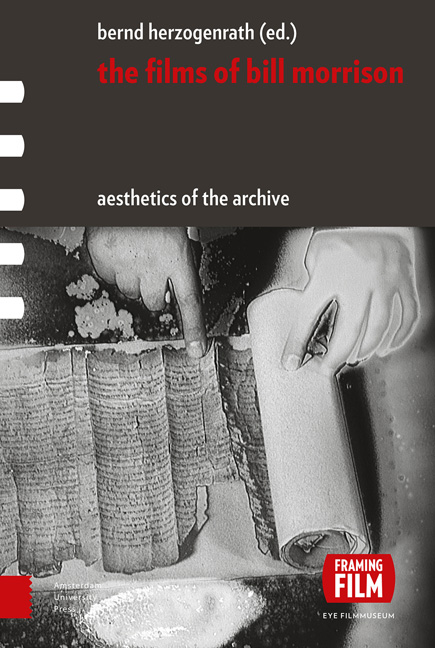Book contents
- Frontmatter
- Contents
- Acknowledgments
- Aesthetics of the Archive: An Introduction
- Chapter 1 Drafts and Fragments: Reflections around Bill Morrison and the Paper Print Collection
- Chapter 2 The Film of Her: The Cine-Poet Laureate of Orphan Films
- Chapter 3 Ghost Trip: Searching for Potential Myths
- Chapter 4 Decasia: The Matter | Image: Film is also a Thing
- Chapter 5 The Mesmerist: Illustrating the Return of the Repressed
- Chapter 6 Light is Calling: Celluloid Dreams
- Chapter 7 Gotham: Zoetrope: Block by Block
- Chapter 8 Outerborough: Early Cinema Revisited
- Chapter 9 The Highwater Trilogy: Thinking the Liquid – On the Ethics of Water and the Material Ecologies of Disaster and Ruination
- Chapter 10 Porch: Archives, Collective Memory, and the Poetics of Home Movies
- Chapter 11 The Future Lasts Long: The Romanov Lost Family Archives
- Chapter 12 Who by Water: Variations on Matter, Figures, Memory, and Mythology
- Chapter 13 Every Stop on the F-Train: Beyond and within the Restless Netherworld of (Manhattan’s) Mind
- Chapter 14 Spark of Being: Bachelor Machine
- Chapter 15 The Miners’ Hymns: Acts of Resurrection
- Chapter 16 Tributes – Pulse: A Requiem for the 20th Century: Death | Drive | Image
- Chapter 17 Just Ancient Loops: The Loops of Life in Intonation
- Chapter 18 The Great Flood: Water is Transparence Derived from the Presence of Everything
- Chapter 19 Re-Awakenings: Bill Morrison in Conversation
- Index of Film Titles
- Index of Names
- Index of Subjects
- Already Published
Chapter 13 - Every Stop on the F-Train: Beyond and within the Restless Netherworld of (Manhattan’s) Mind
Published online by Cambridge University Press: 12 December 2020
- Frontmatter
- Contents
- Acknowledgments
- Aesthetics of the Archive: An Introduction
- Chapter 1 Drafts and Fragments: Reflections around Bill Morrison and the Paper Print Collection
- Chapter 2 The Film of Her: The Cine-Poet Laureate of Orphan Films
- Chapter 3 Ghost Trip: Searching for Potential Myths
- Chapter 4 Decasia: The Matter | Image: Film is also a Thing
- Chapter 5 The Mesmerist: Illustrating the Return of the Repressed
- Chapter 6 Light is Calling: Celluloid Dreams
- Chapter 7 Gotham: Zoetrope: Block by Block
- Chapter 8 Outerborough: Early Cinema Revisited
- Chapter 9 The Highwater Trilogy: Thinking the Liquid – On the Ethics of Water and the Material Ecologies of Disaster and Ruination
- Chapter 10 Porch: Archives, Collective Memory, and the Poetics of Home Movies
- Chapter 11 The Future Lasts Long: The Romanov Lost Family Archives
- Chapter 12 Who by Water: Variations on Matter, Figures, Memory, and Mythology
- Chapter 13 Every Stop on the F-Train: Beyond and within the Restless Netherworld of (Manhattan’s) Mind
- Chapter 14 Spark of Being: Bachelor Machine
- Chapter 15 The Miners’ Hymns: Acts of Resurrection
- Chapter 16 Tributes – Pulse: A Requiem for the 20th Century: Death | Drive | Image
- Chapter 17 Just Ancient Loops: The Loops of Life in Intonation
- Chapter 18 The Great Flood: Water is Transparence Derived from the Presence of Everything
- Chapter 19 Re-Awakenings: Bill Morrison in Conversation
- Index of Film Titles
- Index of Names
- Index of Subjects
- Already Published
Summary
ABSTRACT
Morrison's Every Stop on the F Train is a short film with one of the greatest stars in the United States – Manhattan. As an audiovisual essay, this work does not illustrate or propel a distinct philosophical treatise as it is rather a constructive phenomenological provocation. Every Stop on the F-Train deals with the position of the mind as immersed (or rather manifested) in sound, vision, time, and place, which can be researched here with the unique capacities of film. Playful but also rigorous, machinic but also of humble elegance, this film reworks the linked concepts of motion pictures and locomotion. It destabilizes unquestioned notions of the viewer, content, direction, and directing, thereby harnessing the deeper potential of the medium.
KEYWORDS
space, perspective, tunnel, mass transit
I read, no, I rather screen the short film Every Stop on the F-Train here in a slightly personal manner. My point of departure is an actual ride on the actual F-train in Manhattan in the spring of 2013. I was in New York for the second time – curious, hungry, a bit lost but nevertheless rubbernecking with glee and awe. I came for a graduate conference at CUNY, and, also being a scholar of what is known as American Studies in Germany, I was, in fact, many things: tourist, investigator, customer, and (aged) fanboy.
Every accumulation of people, materials, signs, and rhythms challenges the outsider's mind. The subway is the most urban and, I would argue, the most enigmatic and startling machines of the modern city. While only really big cities have a subway system, its use is not associated with something very prestigious, but it is irritatingly normal, like faucets and electricity. Like those resources, the subway is something that becomes relevant when it is out of order or somewhat suspended. Its effective exploitation depends on a certain amount of assess-ability (but also accessibility) and its individual user's literacy of maps and abstract charts. For me, it depended on Josef, my generous city guide, who could identify approaching redirected trains by the people who were waiting for it. Not only does Morrison's film (like Josef) unfold how eerie and mysterious a seemingly mundane or even boring conveyance actually is, Every Stop on the F-Train also reflects on film as a medium or (self-paced?) tool for such an unfolding of the expanse of an object – and of the definitions by which it normally goes.
- Type
- Chapter
- Information
- The Films of Bill MorrisonAesthetics of the Archive, pp. 199 - 210Publisher: Amsterdam University PressPrint publication year: 2017



